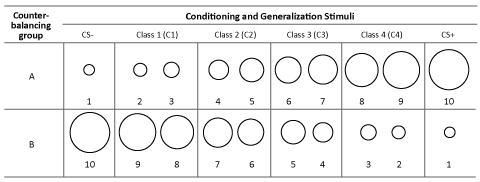
 |
| Figure 1: Conditioning and Generalization Stimuli. Groups were counterbalancing so that for half of the participants, the largest ring was the conditioned danger cue and the smallest ring was the safety cue (counterbalancing group A) and for the other half, the stimuli were reversed (counterbalancing group B). The eight intermediate ring sizes were grouped into four classes (C1, C2, C3, and C4) to avoid an excessive number of trials while maintaining a gradual continuum of ring sizes (see Lissek et al., 2010). |